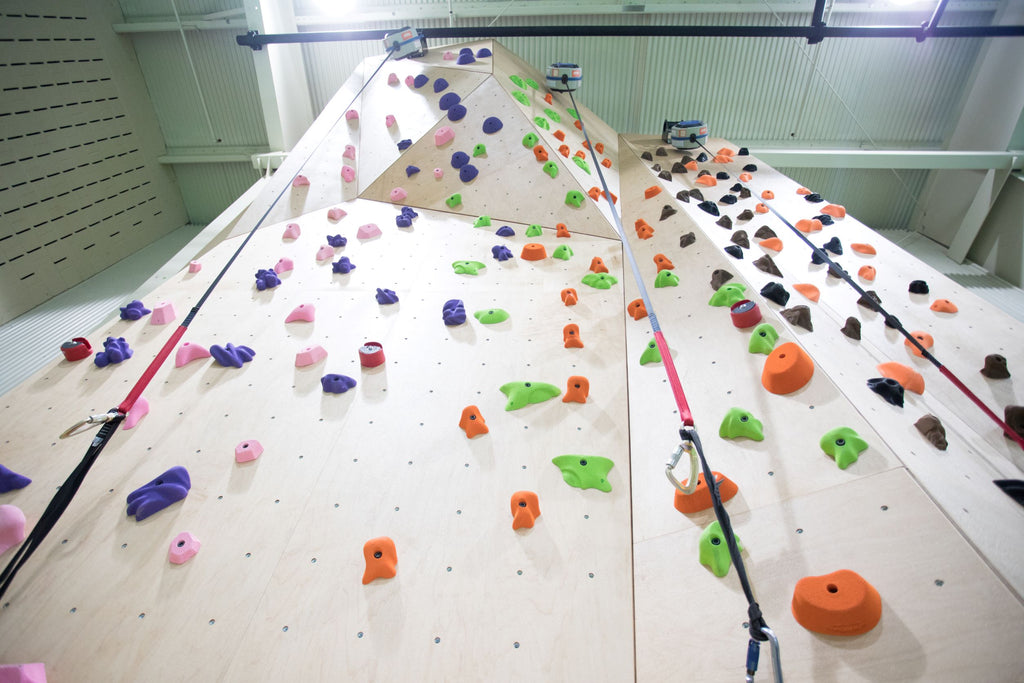
Traditional Belay or Auto Belay? How to Decide What’s Right for Your Climbing Program
If you are adding a vertical climbing wall to your facility, one of the decisions you will need to make is what kind of belay system to use. Since this type of climbing wall is 20 or more feet high, you will need certain safety protocols in place. A belay system keeps climbers safe by connecting them to a safety rope and preventing a fall to the floor. A traditional belay system involves hardware at the top of the climbing wall that secures the safety rope. That rope is connected to the climber and a belayer (or multiple belayers) who controls the rope and pulls in slack as the climber ascends and slowly releases slack to lower the climber to the safety mats after the climb. The belayer also stops the rope from moving if the climber falls, keeping the climber from hitting the floor. An auto belay system also employs a safety rope; however, no partner is involved. The climber is connected to the rope that is connected to the system which automatically raises the rope when the climber ascends, stops if the climber falls and lowers the climber when she or he reaches the top of the climbing wall. Deciding which belay system is best for your program requires some research. Here are some factors to consider:
Belay System Training
Regardless of which system you choose, you will need to be professionally trained on how to use, maintain and inspect your system. A comprehensive, on-site training is included with all our vertical climbing wall packages. The training includes an introduction to climbing, as well as safety and risk management procedures. It also includes information about climbing wall and equipment inspections, maintenance and record keeping. The training is hands-on, so participants have opportunities to climb and learn how to use the belay system. A demonstration of skill and a written assessment are also part of the program. The main difference between the two belay systems is that other people are involved with a traditional belay, working in collaboration to ensure the climber’s safety. With an auto belay system, it is just the climber alone with the belay equipment.

Belay System Staffing
If your organization is going to staff your climbing wall, as is often done at fitness centers, you will need more staff to manage a traditional belay system than an auto belay system. You need at least a one-to-one ratio of climbers and staff, or one belayer per climber, plus additional staff to help with equipment and other tasks. With an auto belay system, you just need staff to train climbers on how to use the system and supervise them. This generally requires fewer staff members than a traditional belay system. Organizations such as camps and schools often have fellow students and campers belay each other, so the staffing is not a concern for them, but proper training of all participants is something they need to implement in their program.
Belay System Costs
An auto belay system is significantly more expensive than a traditional belay system because it is a very technical piece of safety equipment. The installation cost for each system is the same.
Belay System Inspection, Care and Maintenance
Both belay systems need to be properly inspected and maintained. Each system includes a Care & Maintenance Guide, and this information is also be covered in the on-site training. There are regular inspections that need to be conducted and documented. The main difference between the two systems is that the auto belay system needs to be removed, moved to a worktable and inspected after six months. Additionally, it needs to be removed and sent back to the manufacture annually for recertification, which does involve a fee for each device. You need to retain the original boxes and packaging materials to use for sending the auto belays back for this. Keep in mind that the climbing wall will have to be closed during this time. For a traditional belay system, regular inspections do not require removing any of the hardware or equipment and therefore do not have to be closed.
Physical, Cognitive and Social-emotional Benefits
Both types of belay systems allow climbers to literally reach new heights. Vertical rock climbing builds strength, endurance, flexibility and problem-solving skills. Climbers also develop courage, perseverance and self-confidence. A traditional belay system takes the benefits even a step further. The teamwork involved in belaying one another builds leadership, trust, communication and a sense of team.

Leave a comment